by Winding Pathways | Jan 25, 2024 | Nature, Reflections/Profiles
Lots to Experience in January
(reworked from the Patterson’s “Iowa’s Wild Side” column
originally in the Cedar Rapids Gazette)
Winter in Iowa is erratic. Mild. January thaws. Grey, damp, and achy mornings. Frigid. Blustery. Sunny, sparkling days when all is right. We have it all. Here are ways we a find joy in January.
Some people escape to warmer regions. Most of us hang tough and grumble. At Winding Pathways, we’ve found that simple observations can enliven and deepen our appreciation for the change of seasons.
Sit Still
Bundled up in his Carharts and sitting quietly downwind at dusk, Rich notices deer begin to move. Stars and planets glow. Five geese honk and wing across the waxing moon. A photographer’s dream. An owl’s call fills the stillness left behind.
Wildlife freeze as the great horned owl’s ghostly shape floats silently to a branch near our home. Puffed to twice its size, a buffer against the cold, it waits. Several long minutes pass. Then, a rabbit cautiously emerges from the prairie stubble. An opossum noses hungrily at the compost heap. A startled mouse scurries across an open space. With talons extended and yellow eyes gleaming, the owl drops. After a brief scuffle, only bits of fur remain.
-
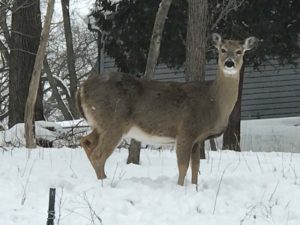
-
Inquisitive doe.
-
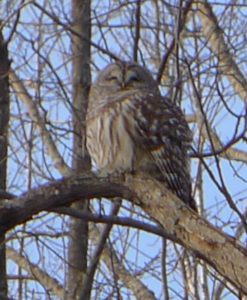
-
Waiting
-
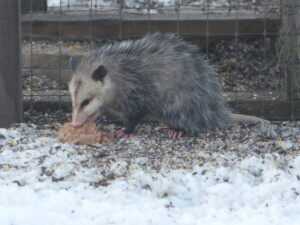
-
Possums’ feet help it climb.
Observe When You Drive
Another way we find Joy in January is by taking drives. Across a frosty Iowa road, we slow as four deer race across a field, leap a barbed wire fence, and dash to safety beyond busy Highway 30. We speculate what startled them. A short time later we observe a face-off between a grazing cow and a foraging hawk. Neck stretched out, nose to the wind, the cow eyes the hovering hawk.
From the comfort of our home, we watch birds. Siskins, when the weather is cold, Carolina wrens when winters are mild, hang around the feeder and shrubs loaded with berries. A red-headed woodpecker pecks at suet. It rattles noisily and jabs its lance-like bill at the less aggressive birds. Its strong bill is great for hammering insects out of frozen trees and pounding holes in ice-encased water baths.
January Ice
Black ice is another winter phenomenon. While not fun to drive on it is intriguing on rivers, ponds, and lakes. One Kansas winter an Arctic airmass plunged into the heartland and gave us a chance to peer into the dark depths below. A snapping turtle slowly swam through the thick water. Ice skaters reveled in the unusual event.
Nowadays we enjoy Arctic air from the inside. A small pool is just outside our window near the feeders. Sometimes, when temperatures drop quickly, and black ice forms we can see “through the looking glass” so to speak. A small aerator keeps a circle of water open. Small birds hop to the edge and drink. The overwintering goldfish appreciate the extra O2.
And we enjoy hot chocolate during January’s dormant month.
by Winding Pathways | Nov 25, 2021 | Mammals, Nature, Preparedness, Uncategorized
Two years ago, hardly anyone knew what the novel Coronavirus was, but since then this crafty virus and the nasty disease it causes, COVID-19, has hardly been all over the news. Like most people we thought it was a disease of only humans.
We were astonished to learn that a high percent of Iowa tested deer has been found positive for COVID. With deer hunting season approaching we wondered if deer pose a threat to people either butchering an animal or eating the meat. So, we contacted Dr. Tyler Harms. He’s the Iowa Department of Natural Resources Deer Program Leader.
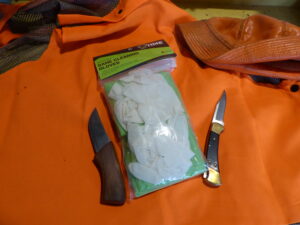
Dr. Tyler Harms, head of deer project in Iowa recommends safety gloves and hand washing when processing and preparing venison.
According to him the threat seems minimal, however, he recommends the following actions for anyone processing a deer:
- Wear rubber gloves when processing an animal.
- Wash hands and equipment thoroughly after handling deer meat
According to Dr. Harms, Iowa’s deer are asymptomatic. They don’t seem to be getting sick or dying.
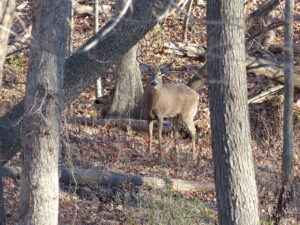
Bucks are still active in December.
December is Iowa’s main deer hunting season. Over 100,000 animals are likely to be harvested. Here at Winding Pathways, we enjoy venison as local, organic, free-range meat. But we’ll be sure to follow Dr. Harm’s advice when handling meat.
In many ways COVID is a mysterious disease. Where it came from remains a hazy mystery, and its variants continue to perplex people. Now it’s been found in animals. Iowa’s deer aren’t the only animals that test positive. The disease has been found in leopards in zoos and mink. It’s likely that many other animals and deer nearly everywhere carry COVID. How they got it and how it’s spread is a mystery.
by Winding Pathways | Oct 22, 2020 | (Sub)Urban Homesteading, Mammals, Pests
Early one September morning a disturbing sight greeted us. The metal post holding a suet feeder high off the ground was bent. The feeder was gone. After a search we finally found it where our nocturnal thieves had abandoned it after devouring the suet.
Many people are frustrated when daytime squirrels gobble up feeder seed, but other mammals visit feeders unseen after sunset. Not all are as rough on feeders as raccoons and all night visitors are interesting but they can also be frustrating.
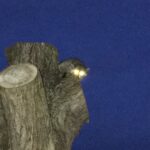
Raccoons are strong and hungry.
Up in the wee hours sleepless or just to get a snack? Shine a flashlight beam on the feeder. You may spot raccoons, deer, flying squirrels, or even a bear! They all like birdseed and some relish suet.
Raccoons live nearly everywhere, even in big cities. Our son once sent a picture he took of one raiding a dumpster in New York City. Occasionally they are out on cloudy days but mostly they are nocturnal.
Raccoons are common, numerous, powerful, and gregarious. Sometimes a whole family visits a feeder after dark. Excellent climbers, if they can’t shinny up a slippery metal pole to reach seed, they might just bend it over as they did at Winding Pathways. They love suet but also eat corn, sunflower seeds, and many other foods people put out for birds.
One of the most endearing animals to visit feeders are flying squirrels. There are two species but both are nocturnal and are almost never seen during daylight. Flying squirrels often live in big dead hollow trees and are more common than most people realize.
Flying squirrels are misnamed mammals. They can’t fly. They should be called gliding squirrels, for they spread loose skin on their sides and glide from the top of a tree to the ground – or bird feeder. These mammals weigh only about two ounces, about half that of an Eastern chipmunk. In comparison, a mature gray squirrel is ten times heavier at about 20 ounces.
Flying squirrels are shy and beautiful. Seeing one is a thrill.
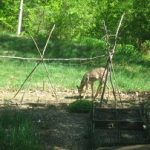
Deer In Garden Photo by S. Fehsinger
Like raccoons and flying squirrels, deer love birdseed. Sometimes they visit during the day but we see them more often after dark. If a feeder is well seed stocked in the evening but is empty come morning deer are likely culprits. Look for their tracks and droppings to confirm the visit.
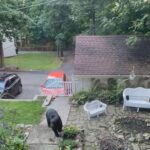
Bears make themselves at home anywhere.
Bears
Gads. Bears at the feeder! Could be. We don’t live in bear country but they are common over much of the United States. Mostly nocturnal, they love birdseed and suet. A 300-pound bear can rip down the most armored feeder and they’re skilled trash can scroungers as well.
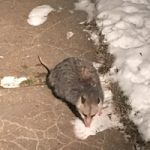
A ‘possum snuffling for food. Photo J. Jones
Skunks, Possums, and Rats
Skunks, opossums, and Norway Rats all love birdseed. Like flying squirrels and raccoons, they are nocturnal. Skunks and possums are native animals that can be comical, but no one wants rats around. They are dangerous pests capable of spreading disease and gnawing on houses.
REDUCING NOCTURNAL FEEDER VISITORS
There’s an effective way to discourage nocturnal feeding wildlife. It’s a two-step process:
- Only put out the amount of seed birds are likely to eat in a day. Empty feeders may attract nocturnal animals but pickings are slim and discouraging.
- Better yet bring all feeders inside by sunset. Store them overnight in a metal trash can with a tight-fitting lid to keep mice from being tempted to raid it even if it’s indoors.
Feeding birds is entertaining and educational. We love having colorful activity just outside our window. We’re not thrilled when raccoons tear up the feeders, so when midnight raiders help themselves, we bring feeders in each evening.
by Winding Pathways | Feb 14, 2019 | (Sub)Urban Homesteading, Mammals, Nature
Guest Blogger
Nancy Garberson shares these observations and photos with Winding Pathways.
This time of year, we call it “wild kingdom” in our backyard because we see deer every day. All kinds of birds and tracks in the snow from the nocturnal creatures dot the snow as well. Our dog is fascinated by the steady entertainment. It’s funny but she never chases them, she respects them as if they were family.
Watching deer roam in our yard can make us feel as if we are living in a natural paradise. Our neighbor has a pond and we have connecting woods. We think that’s what attracts the deer to our area. The deer feel safe and they have lots of water and natural food, as well as our feeder supply, to keep them happy. Another neighbor has an apple tree, which appears to be another draw for the deer. Even the bucks walk in nonchalantly to feed.
So, not only are we enjoying the winter wonderland, but we also have a steady showing of wildlife to enjoy on winter days.
-
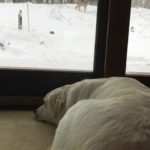
-
Abby takes in the scenery.
-

-
The deer come to the feeder in the late afternoon.
-
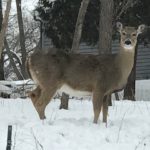
-
Inquisitive doe.
-
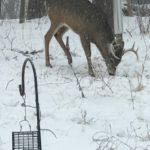
-
Buck in antlers
-
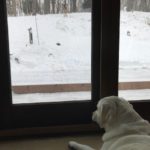
-
Spotting the deer.
by Winding Pathways | Jul 13, 2017 | Chickens, Labyrinths, Wonderment
What fun hosting Bankers Trust staff and clients and welcoming an out of town visitor to the Phoenix Harmony Labyrinth. Tuesday, July 11 was steamy and threatening storms. But, the hardy crew engaged in lively discussions and asked probing questions about the more simple lifestyle we embrace at Winding Pathways. Now, simple does not mean easy. Tending a large yard and five circuit labyrinth are work. Rewarding work. And, people are curious about chickens, managing small gardens, maximizing space, retaining water on our property, heating with wood, and creating diversity that welcomes wildlife. Topics like ways to save energy which saves money to be invested or used caught their attention. And questions on managing pests like ground hogs and deer. We touched on a lot and had a great time.
Go to 1080 Labyrinth for a photo album of the afternoon and evening.
Then, with storms obviously to the south showing off cumulus and anvil clouds but no threat, all walked the Phoenix Harmony Labyrinth. Mike T’s comment summed it all up. As he and Terri entered the center a cool breeze touched their faces. Mike paused and said, “I never want to leave.”
Thanks Terri Doyle for organizing and promoting!














